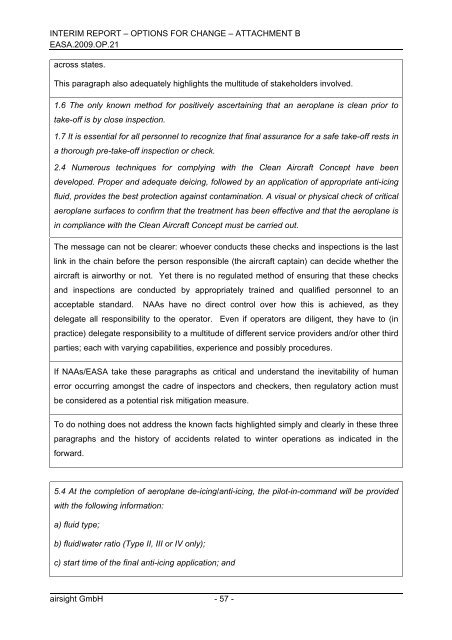Interim Report - Introduction - EASA
Interim Report - Introduction - EASA
Interim Report - Introduction - EASA
You also want an ePaper? Increase the reach of your titles
YUMPU automatically turns print PDFs into web optimized ePapers that Google loves.
INTERIM REPORT – OPTIONS FOR CHANGE – ATTACHMENT B<br />
<strong>EASA</strong>.2009.OP.21<br />
across states.<br />
This paragraph also adequately highlights the multitude of stakeholders involved.<br />
1.6 The only known method for positively ascertaining that an aeroplane is clean prior to<br />
take-off is by close inspection.<br />
1.7 It is essential for all personnel to recognize that final assurance for a safe take-off rests in<br />
a thorough pre-take-off inspection or check.<br />
2.4 Numerous techniques for complying with the Clean Aircraft Concept have been<br />
developed. Proper and adequate deicing, followed by an application of appropriate anti-icing<br />
fluid, provides the best protection against contamination. A visual or physical check of critical<br />
aeroplane surfaces to confirm that the treatment has been effective and that the aeroplane is<br />
in compliance with the Clean Aircraft Concept must be carried out.<br />
The message can not be clearer: whoever conducts these checks and inspections is the last<br />
link in the chain before the person responsible (the aircraft captain) can decide whether the<br />
aircraft is airworthy or not. Yet there is no regulated method of ensuring that these checks<br />
and inspections are conducted by appropriately trained and qualified personnel to an<br />
acceptable standard. NAAs have no direct control over how this is achieved, as they<br />
delegate all responsibility to the operator. Even if operators are diligent, they have to (in<br />
practice) delegate responsibility to a multitude of different service providers and/or other third<br />
parties; each with varying capabilities, experience and possibly procedures.<br />
If NAAs/<strong>EASA</strong> take these paragraphs as critical and understand the inevitability of human<br />
error occurring amongst the cadre of inspectors and checkers, then regulatory action must<br />
be considered as a potential risk mitigation measure.<br />
To do nothing does not address the known facts highlighted simply and clearly in these three<br />
paragraphs and the history of accidents related to winter operations as indicated in the<br />
forward.<br />
5.4 At the completion of aeroplane de-icing/anti-icing, the pilot-in-command will be provided<br />
with the following information:<br />
a) fluid type;<br />
b) fluid/water ratio (Type II, III or IV only);<br />
c) start time of the final anti-icing application; and<br />
airsight GmbH - 57 -

















